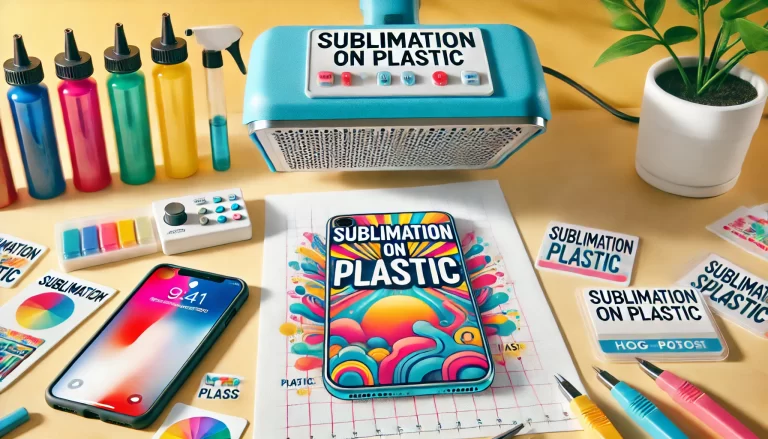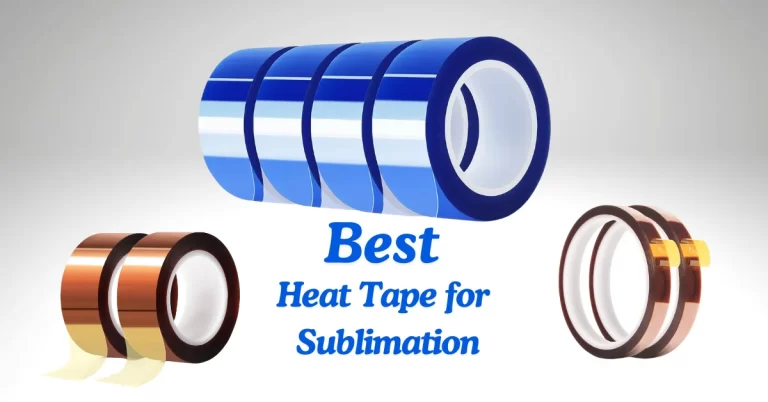Does Sublimation Coating Work? Exploring the Benefits
Sublimation coating is a specially formulated layer applied to a variety of materials (such as metal, ceramics, wood, etc.) to make them receptive to sublimation inks. The coating allows the sublimation dyes to bond permanently to the material, producing prints that last for a long time.
Heat and pressure cause the sublimation inks to turn into gas and penetrate the coated surface, fusing directly into it. This produces a print that is of high quality and durability and won’t easily peel, crack, or fade.
What is Sublimation Coating?
Sublimation printing requires sublimation coating, which allows for vibrant and long-lasting prints on various surfaces. This special coating connects the sublimation ink to the substrate, enabling the ink to bond permanently with the material.
Applying a sublimation coating allows you to expand the range of materials suitable for sublimation printing and achieve impressive results.
Does Sublimation Coating Work?
Yes, it works. Improved adhesion and durability can lead to vibrant and long-lasting sublimation prints on ceramics, metals, glass, and polyester fabrics.
To decorate mugs, stainless steel items, or glass surfaces, it’s necessary to understand the fundamentals of sublimation coating. The process of sublimation coating, its components, application methods, and its effectiveness across different substrates will be explored in this article.

Best Practices for Applying Sublimation Coating
To get the best results, follow these best practices:
- Surface Preparation:
Ensure the surface is clean and free from oils, dust, and contaminants. Wipe down with a microfiber cloth and a mild cleaning solution if necessary. - Application Method:
Use a spray or dip method to apply the coating. If spraying, ensure an even mist over the surface. Hold the spray can about 6-8 inches from the material to avoid uneven spots or drips. Allow the coating to dry for the recommended time (usually around 1-2 hours depending on the product). - Curing:
Most coatings need to be cured at a specific temperature for optimal bonding. Typically, you’ll need to bake the coated item at 350°F (175°C) for around 5-10 minutes, but check your product’s specific guidelines. - Common Problems:
- Uneven Coating: Ensure you’re using smooth, even strokes when spraying or dipping. Avoid over-saturating the surface, which can cause streaks or pooling.
- Fixing Uneven Coats: If the coating has dried unevenly, lightly sand the surface and reapply.

How to Make Sublimation Coating for Mugs
- To create the coating, you’ll require a few essential components: a top-notch sublimation coating powder, some distilled water, and a container for mixing.
- Measure the components: Follow the recommended ratio the coating powder manufacturer provides. Typically, it involves mixing a specific amount of coating powder with a particular volume of distilled water. Ensure precise measurements for optimal results.
- Mix the components: Gradually add the coating powder to the distilled water while stirring continuously. Gradually add the coating powder to the distilled water while stirring continuously. To ensure a uniform and silky mixture, you have the option of utilizing either a stirring implement or a mixer. Continue stirring until the powder is completely dissolved.
- Let it rest: Allow the mixture to rest for a designated period, as recommended by the coating powder instructions. This resting time stabilizes the solution and ensures the best performance during application.
- To eliminate any possible clumps or impurities, use a fine mesh strainer or cheesecloth to strain the mixture.
- Transfer the coating to a storage container: Pour the strained coating solution into a clean and airtight container. Label the container appropriately for future reference.
Making Sublimation Coating Liquid
- Select a sublimation coating concentrate: Different brands offer a wide range of sublimation coating concentrates. It is essential to select a high-quality concentrate that matches your specific coating needs and requirements.
- Dilute the concentrate: Follow the manufacturer’s instructions for dilution ratios. Mixing the concentrate with distilled water is usually required. Measure the appropriate amounts of concentrate and water based on the recommended ratio.
- Mix thoroughly: Pour the concentrate into a mixing container, and gradually add the distilled water while stirring continuously. Use a stirrer or a mixer to ensure a homogeneous mixture. Continue stirring until the concentrate is fully diluted.
- Resting time: Allow the mixture to rest for a specific duration, as specified by the manufacturer. This resting period stabilizes the components and ensures optimal application performance.
- Transfer to a storage container: Pour the diluted sublimation coating liquid into a clean, air-tight container. Properly label the container for future reference.
Sublimation Coating Formula
Here are two possible formulas for sublimation coating, each specific to different materials:
For Ceramic Mugs:
|
Components |
Amount |
|---|---|
|
Epoxy resin |
100 g |
|
Hardener |
50 g |
|
Acetone |
50 ml |
|
Sublimation coating powder |
10 g |
Instructions:
- Mix the epoxy resin and hardener thoroughly.
- Add the acetone and sublimation coating powder to the mixture.
- Stir the mixture until smooth and nicely combined.
- Apply the coating to the ceramic mug using a brush or spray.
- Let the layer dry for 24 hours before proceeding with sublimation printing.
For Fabric Sublimation:
|
Components |
Amount |
|---|---|
|
Carboxymethyl cellulose sodium (CMC) |
1.0% |
|
Polyethylene oxide (PEO) |
1.0% |
|
Defoaming agent (TEGO Airex 904 W) |
1.0% |
|
Silicon dioxide |
2.0% |
|
Sunlight fastness agent |
5.0% |
|
Water |
90.0% |
Instructions:
- Mix all the components thoroughly until well combined.
- Apply the coating mixture to the fabric using a spray bottle or roller.
- Let the coating dry for 12 hours before proceeding with sublimation printing.
Sublimation is an endothermic process where a substance shifts directly from a solid to a gas state without passing through the liquid phase. It occurs at temperatures and pressures below the substance’s triple point on its phase diagram.
Why is My Sublimation Print Fading or Peeling?
3 factors could be causing prints to fade or peel.
- Incorrect Coating Application:
- If the sublimation coating isn’t applied evenly or cured properly, the print may not adhere correctly. Ensure you’re following the right steps for applying and curing the coating.
- Low-Quality Coatings:
- Low-quality or incompatible sublimation coatings may result in fading. Invest in high-quality coatings suited for your materials. Always choose coatings designed specifically for sublimation.
- Environmental Exposure:
- Prolonged exposure to UV light, extreme heat, or harsh chemicals can cause sublimation prints to degrade. Ensure your sublimated products are stored in appropriate conditions.
- Solution:
- Reapply the coating properly, ensuring you follow drying and curing instructions exactly. If fading persists, consider switching to a more durable sublimation coating designed for long-lasting results.
What is Sublimation Coating Made Of?
Coatings are made with components depending on the type of material and ink used. These 8 common ones work together to provide the necessary adhesive properties and ensure accurate image transfer.
1. Epoxy resin and hardener: Used for coating hard surfaces such as ceramic, metal, and wood. They create a durable, glossy layer that can withstand high temperatures and pressures.
2. Polyglass and depress catalysts: Used to coat hard surfaces like stainless steel. They form a transparent and smooth layer that bonds well with the metal.
3. Carboxymethyl cellulose sodium (CMC) and polyethylene oxide (PEO): Used for coating fabric materials like cotton and silk. They create a thin and flexible layer that absorbs ink while preventing bleeding. (CMC) is a cellulose derivative with carboxymethyl groups (-CH2-COOH). The structure of PEO is commonly expressed as H−(O−CH2−CH2)n−OH
4. Silicon dioxide: Acts as a filler or thickener for the coating, improving viscosity and stability.
5. Sunlight fastness agent: This enhances the coating’s color durability and resistance to sunlight, preventing fading or discoloration.
6. Defoaming agent: Reduces the formation of bubbles or foam in the coating, improving its smoothness and uniformity.
7. Acetone: Used as a solvent or thinner to adjust the consistency and flow of the coating.
8. Sublimation coating powder: A special additive that enhances sublimation performance, increasing ink adhesion and transfer efficiency.
How to Apply Sublimation Coating
- Before applying the coating, it is crucial to prepare the surface properly. Please make certain that the surface is meticulously cleaned, ensuring the removal of any dust, grease, or other contaminants so that no traces remain. Use a mild detergent or surface cleaner to clean the substrate meticulously, and allow it to dry completely before moving forward.
- Choose the application method: Depending on the coating type and your preference, you can apply sublimation coating using techniques such as spraying, brushing, or dipping. Based on the nature of the surface and the coating material, select the most suitable method.
- Follow the instructions: Refer to the manufacturer’s guidelines for your specific coating product. To achieve the best results, follow the recommended dilution ratios, mixing instructions, and application techniques.
- Apply the coating: Start applying the sublimation coating evenly and smoothly onto the substrate using the chosen application method. Ensure complete coverage while avoiding excessive buildup or pooling of the coating.
- Let it dry and cure: According to the manufacturer’s instructions, allow the coated substrate to dry and cure. This may involve air drying, heat curing, or a combination of both. Proper curing is essential for the coating to bond effectively and create a receptive surface for sublimation printing.
- Verify the coating quality: Once arid and cured, visually inspect the surface to ensure uniform coverage and smoothness. The substrate is now ready for sublimation printing.
Sublimation Coating Spray for Mugs
Sublimation coating sprays offer a convenient and efficient way to apply the coating onto mugs, ensuring even coverage and a smooth finish. These specialized sprays are formulated explicitly for sublimation applications and are designed to adhere to various mug surfaces.
To use a coating spray for mugs, shake the can well, hold it at a distance from the mug, and spray a thin, even layer of coating onto the surface.
Allow the coating to dry thoroughly before proceeding with the sublimation printing process. Coating sprays for mugs provide an accessible solution, especially for small-scale projects or when precise control over the coating application is desired for more about sublimation shirt.
DYNWAVE Bottle Sublimation Coating Spray – Brighter Printing Presses Accessories

Features:
- For Polyester & Canvas: Optimized for vibrant, long-lasting prints on polyester and canvas.
- Improved Printing Quality: Works with sublimation ink and transfer paper for vivid colors.
- Protective Coating: Resists scratches, smudging, and wear for durable prints.
- High Gloss Finish: Adds a polished, professional look to designs.
- Versatile Use: Suitable for fabrics, metal, wood, and more. Perfect for T-shirts, hoodies, and gifts.
Pros
- Enhances Printing Quality: Achieve brighter and more vibrant prints with the help of this sublimation spray.
- Long-lasting Protection: The coating creates a durable barrier that safeguards your prints against everyday wear and tear.
- Versatile Application: It can be used on different fabrics and materials, making it a versatile accessory for sublimation printing.
- Easy to Use: No mixing required; spray the sublimation coating directly on the fabric for an instant lustrous effect.
- Professional Finish: The high gloss appearance provided by this spray elevates the overall look of your sublimated designs.
Cons
- Limited Compatibility: This sublimation spray is specifically formulated for polyester and canvas materials, so it may not work optimally on other fabric types.
- Scent: Some users have reported a slight scent upon application, which may be noticeable during printing.
How to Make Sublimation Coating for Stainless Steel
- Select the coating components: Choose a sublimation powder or concentrate suitable for stainless steel substrates. Ensure the coating is formulated to withstand high temperatures and adhere to metal surfaces.
- Follow the manufacturer’s instructions: Refer to the manufacturer’s guidelines for the recommended coating formula and dilution ratios. Follow the instructions closely to achieve the desired results.
- Mix and prepare the coating: Measure the appropriate amount of coating powder or concentrate and combine it with the recommended solvent or diluent, typically distilled water. Mix thoroughly until a homogeneous solution is obtained.
- Apply the coating: Using a suitable application method, such as spraying or brushing, apply the sublimation coating evenly onto the prepared stainless steel surface. Ensure complete coverage without excessive buildup.
- Follow the manufacturer’s instructions to allow the coating to dry and cure properly. This step is crucial for achieving optimal adhesion and durability of the layer.
Sublimation Coating for Glass
- Select the appropriate coating: Choose a sublimation coating for glass surfaces. These coatings are designed to create a receptive layer on glass that allows the sublimation ink to bond effectively.
- Prepare the glass surface: Clean the glass thoroughly to remove dust, fingerprints, or residues. Ensure the surface is dry before applying the coating.
- Apply the sublimation coating to the glass surface by following the instructions provided by the manufacturer. This can involve methods such as spraying, brushing, or dipping the glass into the coating solution. This may involve spraying, brushing, or dipping the glass into the coating solution.
- Dry and cure the coating: Allow the coating to dry entirely and follow any recommended curing processes to ensure optimal adhesion and durability.

Troubleshooting: Bubbles, Cracking, and Application Issues
Bubbles in Coating:
Bubbles can occur when the application method isn’t ideal or when the coating has been applied too thickly.
- Fix: Sand the bubbled areas lightly and reapply the coating in thin, even layers. Allow each layer to dry fully before applying the next.
Cracking After Transfer:
Cracking often happens when sublimation is applied to a material that’s too rigid or if the coating wasn’t fully cured before the transfer.
- Fix: Ensure the surface is flexible enough for sublimation (e.g., don’t apply sublimation coating to very hard plastics without ensuring they’re compatible). Double-check your curing time and temperature.
What Are the Best Sublimation Coatings for Different Materials?
Different materials require specific types of coatings for optimal results:
- Ceramic:
Ceramic items need a coating designed for smooth, glossy finishes. Look for coatings labeled specifically for ceramics, as they create a perfect surface for vibrant prints. - Metal:
Metal items need a coating that can handle the heat pressure of the sublimation process without distorting the finish. Use specialized coatings designed for metals that provide high durability. - Wood:
Wood has a porous surface, so it requires a coating that can seal the material while allowing the sublimation inks to bond effectively. Use a wood-specific sublimation coating that seals the surface properly. - Non-Polyester Materials:
Sublimation typically works best with polyester or polymer-coated surfaces. For non-polyester materials, you’ll need a special coating that allows sublimation to bond to natural fabrics, glass, or wood.
Temperature Settings and Curing
Yes, heat is essential for curing sublimation coating to activate the bonding properties and ensure a lasting print.
- Optimal Temperature for Curing:
Most sublimation coatings should be cured at around 350°F (175°C). However, the exact temperature and time may vary based on the coating brand and the material used. Always check the manufacturer’s recommendations for precise details. - Time Settings:
Curing time is typically 5-10 minutes, but this can vary depending on the thickness of the coating and the type of material you’re working with. Monitor the process closely to avoid over- or under-curing.
Where to Buy Sublimation Coatings and Supplies
You can find from online retailers and specialty shops, including:
- Sublimation-specific suppliers like Subli Genius Print, Heat Press Nation, SubliCraft, and Coastal Business Supplies.
- E-commerce platforms like Amazon, eBay, or Etsy.
- Local craft or printing supply stores may also offer sublimation products.
When buying online, always check customer reviews and ratings to ensure you’re getting high-quality coating that matches your project needs.
Why Is My Sublimation Transfer Not Coming Out Well?
It could be due to several factors:
- Improper Temperature/Pressure:
Make sure your heat press is set to the correct temperature (usually around 400°F or 204°C) and apply consistent pressure for the required time (about 45-60 seconds). - Poor Quality Coating:
If the coating isn’t high-quality or hasn’t bonded properly with the material, the print may not transfer as expected. Reapply or switch to a better coating designed for your material. - Incorrect Paper or Ink:
Ensure you’re using sublimation paper and ink that are compatible with your heat press and the material you’re printing on.
Explore the world of sublimation and printers with our comprehensive guide, for more information or a step-by-step Contact Us.
Final Words:
In conclusion, sublimation coating does work and offers numerous benefits in customization and printing. From mugs to stainless steel and glass, applying sublimation coating opens avenues for creating unique and personalized products.
By mastering the techniques of sublimation coating and utilizing the appropriate formulas, you can achieve exceptional results and ensure customer satisfaction.
FAQs
FAQs:
What materials can be coated with sublimation coating?





